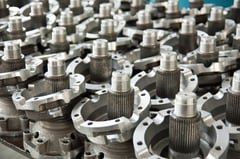
AMRs in the spotlight: Small & Medium Enterprises
Are AMRs the best way to meet your future intralogistical needs? That’s the question we at the Invar Group have been examining over the past few weeks. Given how much of a growth technology these autonomous mobile robots have been experiencing, and how much interest they have been garnering, it’s not hard to imagine that many sectors are moving from a “if” to a “when” mentality in terms of AMR adoption.
But is this really sensible?
Are AMRs really the logical next step for your sector specifically? What are the real advantages and drawbacks of going down this route? This week, the Invar Group continues its examination of the market as a whole, and asks the question – Are AMRs right for your business?
Small-Medium enterprises – S-Tier
Up until this point in our series examining AMR applicability across the market, we have been focusing on market segmentation as defined by products and customer market. We’ve explored supermarkets, pharmaceutical suppliers, and B2C ecommerce among others. But in this examination, we’ll be using a different lens and considering this question – how well do AMRs apply when you segment the market by business size? If you’re a small to medium sized enterprise (SME) the answer is “Very”
Rapid installation – SMEs looking to move into an automated sector are highly vulnerable to disruption. SMEs in the majority of cases have less cash reserves to fall back on, a smaller client base to count on, and overall less business resources that can be spent during any downtime caused by the installation of new technology. This is why SMEs get the very most out of the rapid installation timetable that AMRs can offer. With most of their equipment for mobility and navigation being neatly self-contained, AMRs main slowdown when it comes to installation is software configuration, warehouse arrangement, and the installation of a set of data matrix floor code panels and sensor reflectors. This can all be accomplished in a matter of weeks. A far cry from the months and even years it might take to install a dedicated static rails-and-gantry based ASRS (automated storage and retrieval system) or network of complex conveyor platforms. For SMEs, the speed at which AMRs can be installed is an enormous advantage. One that makes businesses of this size well placed for AMR applicability.
Sidestepping the staffing surge – For any SME that needs to own and operate a warehouse, one of the most difficult and costly problems is peak season. Whether it’s the classic November to February window of B2C ecommerce, or any number of other sectors with their own specific peak times, peak season presents a plethora of problems alongside the potential plentiful profits. In any manually managed warehouse, you will need to hire a host of new staff to keep things up to pace. The hiring process itself can be expensive, never mind the training, managing salaries, admin, and all the other associated costs. With AMRs, you have the option of increasing speed without the hiring hassle. By deploying more robots onto the warehouse floor, seasonal surges can be managed more efficiently and with considerably more controllable costs. By contrast, static ASRSs and other similar systems struggle to be accelerated once installation is in full effect. With AMRs the flexibility of arrangement and the simplicity of short-term scalability make them an ideal choice for SMEs of all sectors.
Ample accuracy – SMEs are more vulnerable than most to the reputational and economic damage caused by order-based errors. The smaller overall business size and client base means that any and all errors will have an outsized impact on overall operations. Thus, any system that can radically minimise such possibilities should be seriously considered. This is exactly what AMRs offer. By eliminating many of the points of possible manual intervention and error, they create a chain of control that is one hundred percent automatic and digital. Errors become fewer, your business’s baseline is more robust, and your overall operations are far more secure.
Expedited expansion – Very few SMEs are looking to keep that acronym for very long. The ultimate goal is to grow into the high end of M, and then much further out beyond. For that to be possible however, you need systems and setups that can handle expansion without disruption. This is an area where AMRs step into the limelight. Due to their highly minimal infrastructure requirements and their high level of program/re-programmability, they make exceptionally flexible options when it comes to expansion expectations. By contrast, systems such as static built in place ASRS need extensive rebuilding, re-engineering, and even potentially entirely new premises. Not the kind of option every SME has to hand when they want to expand. If you are an SME with eyes on moving to L, AMRs make an excellent option for your intralogistical needs.
Talk to Invar about your options – Maybe you think AMRs will solve your SME logistical situations, or maybe you’re not so sure. If you want a wider perspective on the issue, talk to Invar today.
Written by

Michael Trimmer

Contact Us
Contact us for further independent advice on transforming operational performance in the warehouse.
Contact usRelated Articles

AMRs in the spotlight: Pharmaceuticals
What do Issac Azimov, Hollywood blockbusters, and the wider intralogistics community have in...
Read More
AMRs in the spotlight: Manufacturers (B-Tier)
Is the robotic revolution really right round the corner? Is automation the automatic assumption of...
Read More
AMRs in the spotlight: Industrial parts
Autonomous Mobile Robots (AMRs) stand as a beacon of innovation, captivating various sectors with...
Read More